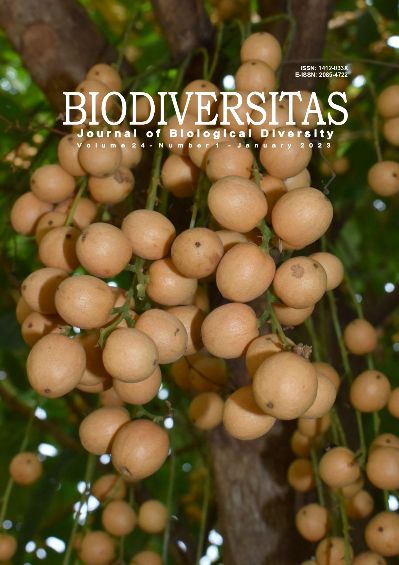DNA barcoding of crustacean larvae with two new records of Caridina gracilipes and Ptychognathus altimanus in the Western Region of Segara Anakan lagoon in Indonesia
##plugins.themes.bootstrap3.article.main##
Abstract
Abstract. Winarni ET, Simanjuntak SBI, Nuryanto A. 2023. DNA barcoding of crustacean larvae with two new records of Caridina gracilipes and Ptychognathus altimanus in the Western Region of Segara Anakan lagoon in Indonesia. Biodiversitas 24: 341-348. Several studies have been carried out on crustacean larvae diversity, but they focused on the eastern and central regions of the Segara Anakan lagoon/estuary, Cilacap District, Central Java Province, Indonesia. Furthermore, one study has explored crustaceans in the western region but focused on adult individuals and used morphological characteristics. Currently, there is no internet data on the crustacean larvae diversity from the estuary's western region, and there is a high possibility that some species are unidentified. This study aims to describe crustacean larvae diversity in the western region of the Segara Anakan lagoon in Indonesia by using DNA barcoding. Sequence divergence of 3% to databases in GenBank and BOLDsystems was used as a genetic threshold for species border. A total of 14 morphotypes were barcoded, but only nine were successful, of which three were identified as bacteria and six as crustaceans. Based on the predetermined genetic threshold, all crustacean morphotypes can be identified at the species level, and six species were obtained. Meanwhile, a previous study on the adult individual only identified specimens at the genus level, and only one genus was similar to these obtained results. A total of 5 out of 6 species were new records to the western region Cilacap, while 2, namely Caridina gracilipes and Ptychognathus altimanus, are newly recorded in the Segara Anakan lagoon. These results contribute significantly to the information on crustacea larvae diversity, which is essential for sustainable management.
##plugins.themes.bootstrap3.article.details##
Most read articles by the same author(s)
- SUHESTRI SURYANINGSIH, SRI SUKMANINGRUM, SORTA BASAR IDA SIMANJUNTAK, KUSBIYANTO KUSBIYANTO, Diversity and longitudinal distribution of freshwater fish in Klawing River, Central Java, Indonesia , Biodiversitas Journal of Biological Diversity: Vol. 19 No. 1 (2018)
- AGUS NURYANTO, DIAN BHAGAWATI, ELLY TUTI WINARNI, ASWI ANDRIASARI ROFIQOH, First record of red seabream, Pagrus major existence in the eastern Indian Ocean south of Java, Indonesia revealed by DNA barcoding , Biodiversitas Journal of Biological Diversity: Vol. 24 No. 11 (2023)

